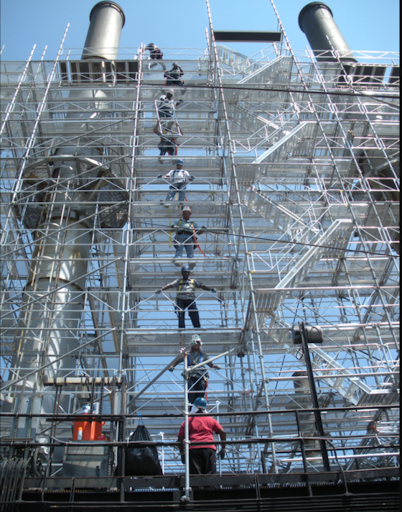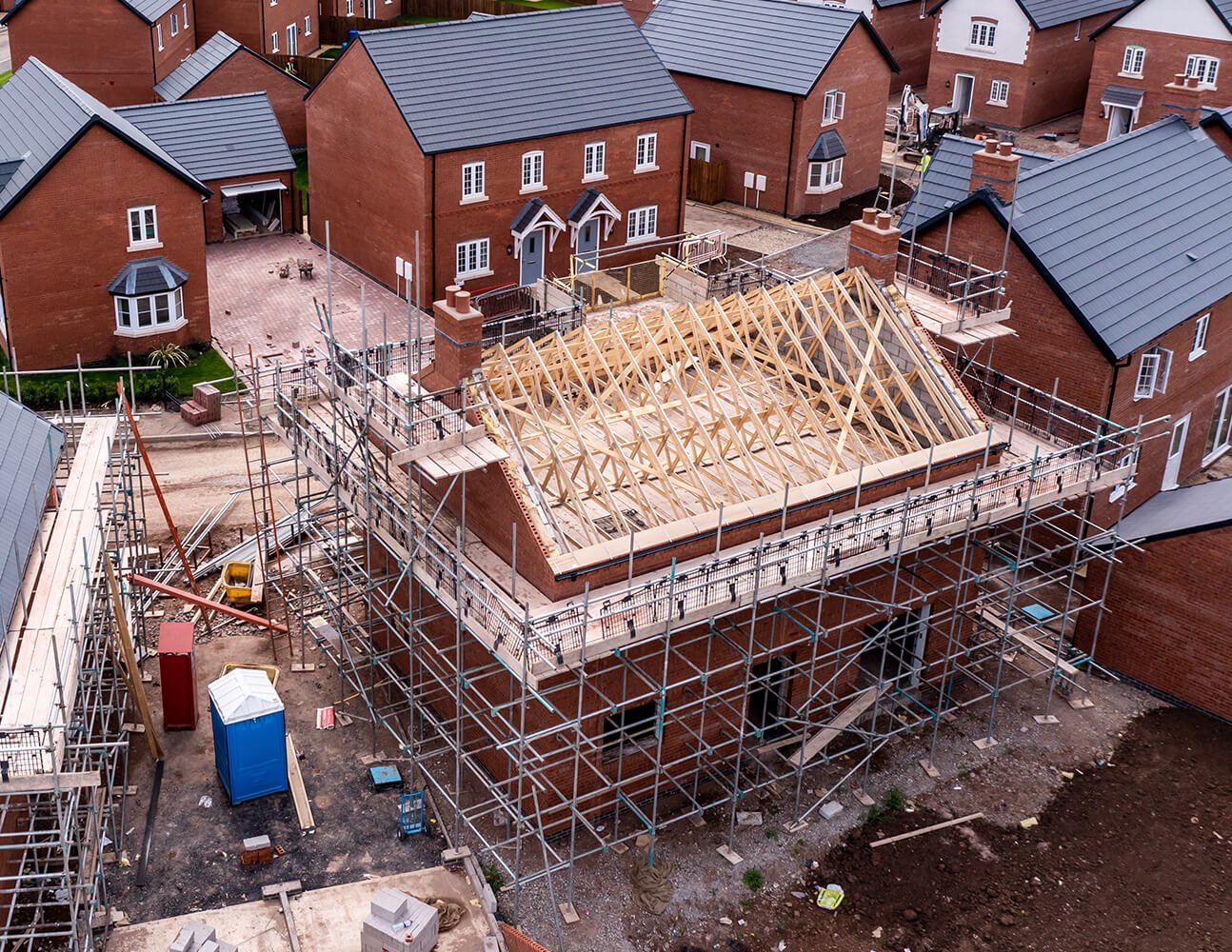High-Quality Residential Scaffolding for Seamless Home Renovations in Surrey
High-Quality Residential Scaffolding for Seamless Home Renovations in Surrey
Blog Article
A Comprehensive Guide to the Crucial Functions of Scaffolding in Modern Building
The landscape of contemporary building and construction increasingly depends on reliable scaffolding systems that prioritize efficiency, security, and technology. As jobs expand in intricacy, understanding the crucial features of scaffolding becomes vital for making certain employee safety and optimizing project timelines. This guide discovers numerous kinds of scaffolding, highlights key safety features, and checks out material advancements that add to performance and sustainability. However, the implications of these elements extend far beyond plain building techniques, motivating a more detailed check out exactly how they affect total job success and worker well-being.
Sorts Of Scaffolding
Although scaffolding systems can differ widely in style and application, they generally drop into a number of distinctive groups that deal with various building demands - Scaffolding. The most usual kinds consist of supported scaffolding, suspended scaffolding, and rolling scaffolding
Sustained scaffolding consists of systems supported by a structure of posts, which offer a stable and raised working surface area. This kind is generally made use of for jobs that require considerable elevation, such as bricklaying or external painting.
Suspended scaffolding, on the other hand, is used for tasks calling for accessibility to high altitudes, such as cleaning or repairing building facades. This system hangs from one more framework or a roof, enabling workers to lower or increase the platform as needed.
Moving scaffolding functions wheels that permit for very easy mobility across a task site. It is particularly useful for jobs that call for regular moving, such as interior work in large rooms.
Each kind of scaffolding is developed with particular applications in mind, guaranteeing that construction projects can be executed efficiently and efficiently. Understanding these groups is critical for picking the ideal scaffolding system to meet both project needs and site problems.
Secret Safety Attributes
Security is critical in scaffolding systems, as the possible threats connected with working at elevations can cause significant crashes if not properly taken care of. Secret security attributes are important to make sure the well-being of employees and the honesty of the building site.
First and leading, guardrails are essential. These barriers offer a physical safeguard versus falls, dramatically decreasing the threat of severe injuries. Furthermore, toe boards are usually used to stop tools and materials from dropping off the scaffold, safeguarding workers listed below.
Another crucial component is using non-slip surfaces on systems. This function boosts grip, particularly in adverse climate condition, consequently decreasing the possibility of drops and slides. Additionally, gain access to ladders need to be safely placed to promote safe entrance and exit from the scaffold.
Routine assessments and upkeep of scaffolding systems are also vital. These examinations make certain that all components remain in great problem and working appropriately, resolving any kind of wear or damages without delay.
Last but not least, proper training for all personnel involved in scaffolding procedures is important to guarantee that they understand security protocols and can determine potential risks. Scaffolding. Collectively, these features create a safer working atmosphere and significantly minimize threats connected with scaffolding
Material Innovations
Advancements in product scientific research have actually significantly influenced the scaffolding sector, improving both security and effectiveness in contemporary building. The introduction of high-strength steel and light weight aluminum alloys has actually reinvented traditional scaffolding systems. These products are not only lighter, making them easier to carry and put together, yet likewise offer superior load-bearing capabilities. This results in scaffolding frameworks that can support better weights while decreasing the danger of collapse.
Furthermore, ingenious composite materials, such as fiberglass-reinforced plastics, have actually arised as feasible choices. These products are resistant to rust and environmental deterioration, therefore expanding the life expectancy of pop over to these guys scaffolding systems, particularly in extreme weather conditions. The usage of such materials adds to lower maintenance prices and makes sure consistent efficiency with time.


Design Factors To Consider
Considering the intricacies of modern construction projects, reliable scaffolding design is extremely important to guaranteeing both capability and safety and security. Design factors to consider must click for info include numerous variables, consisting of load capability, elevation, and the certain demands of the construction website. Each task presents special obstacles, requiring a versatile strategy to scaffolding systems that can adjust to varying conditions.
Architectural integrity is essential; for that reason, designers have to calculate the lots that the scaffolding will certainly support, including workers, materials, and devices. The choice of materials plays a crucial role in making sure the scaffolding can hold up against these loads while continuing to be light-weight and durable. Furthermore, the layout must permit simple gain access to and egress, assisting in the smooth activity of materials and personnel.
Safety features, such as guardrails and non-slip surface areas, must be integrated to lessen dangers of mishaps. The design must take into consideration the surrounding setting, consisting of prospective risks and adjacent frameworks. By attending to these style considerations, construction companies can improve the performance of scaffolding systems and advertise a much safer working environment, inevitably adding to the overall success of the task.
Maintenance and Examinations
The efficiency of scaffolding systems extends past preliminary design and application; continuous maintenance and normal evaluations are important to guaranteeing their continued performance and safety and security throughout the duration of a task. Normal assessments ought to be performed by qualified employees to determine any indications of wear, damages, or instability that might jeopardize the honesty of the scaffolding.
Upkeep protocols ought to include regular checks of structural elements, such as installations, planks, and frameworks, guaranteeing that all elements stay free and protected from deterioration or other deterioration. Furthermore, the capability of safety functions, such as guardrails and toe boards, have to be examined to make certain compliance with security guidelines.
Documents of all assessments and upkeep activities is vital for liability and regulatory compliance. A systematic technique to record-keeping not just help in tracking the problem of the scaffolding but also gives needed proof in the occasion of an incident.
Eventually, establishing a thorough upkeep and examination schedule will significantly decrease the danger of accidents and improve the general security of the building site. By focusing on these techniques, construction supervisors can secure employees and copyright the job's stability.

Verdict
In final thought, the vital features of scaffolding in contemporary construction incorporate a series of essential aspects, including diverse kinds, essential safety mechanisms, product developments, and thoughtful layout considerations. Stressing security through guardrails and non-slip surface areas, alongside improvements in products like high-strength steel, enhances both performance and sustainability. Additionally, normal upkeep and examinations are crucial for making sure structural stability and safety and security on construction websites, inevitably promoting effective task execution and promoting the wellness of employees.
The landscape of contemporary building and construction significantly counts on effective scaffolding systems that prioritize safety, innovation, and performance.Developments in product science have actually substantially influenced the scaffolding market, improving both safety and efficiency in modern construction. Overall, these product advancements not only improve the performance and safety of scaffolding systems but also straighten with the market's press in the direction of sustainability, as lots of contemporary materials are designed to be a lot more eco friendly.
Considering the intricacies of contemporary building projects, efficient scaffolding design is paramount to making certain both performance and safety.In verdict, the important features of scaffolding in modern-day building encompass a variety of vital elements, consisting of diverse types, crucial security mechanisms, product advancements, and thoughtful design factors to consider.
Report this page